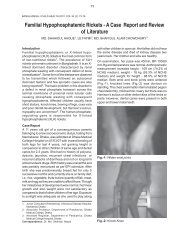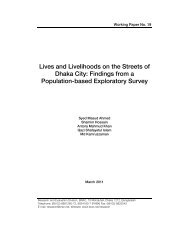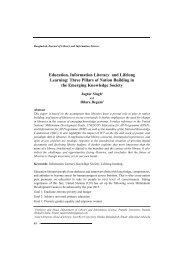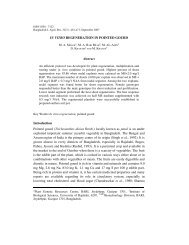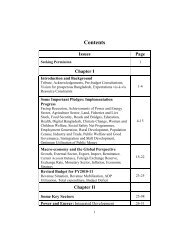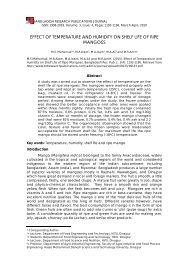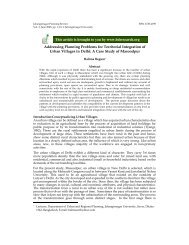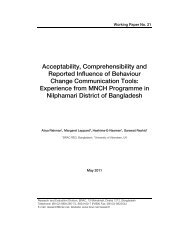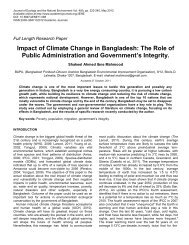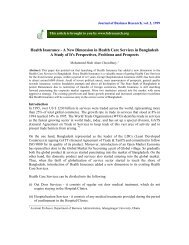Economic Value Added _Formated_.pdf
Economic Value Added _Formated_.pdf
Economic Value Added _Formated_.pdf
Create successful ePaper yourself
Turn your PDF publications into a flip-book with our unique Google optimized e-Paper software.
Bank Posikrama<br />
Volume XXVII,No.1, March 2002 (pp. 46-63)<br />
<strong>Economic</strong> <strong>Value</strong> <strong>Added</strong> as a Management Tool-<br />
A Study on Selected Banking Companies<br />
in Bangladesh<br />
-Mohammad Saleh Jahur*<br />
- Al Nahian Riyadh ∗<br />
Abstract<br />
<strong>Economic</strong> <strong>Value</strong> <strong>Added</strong> (EVA) is now being considered as an important management<br />
tool across the corporate world for measuring and rewarding performance inside the<br />
companies. Most of the companies measure performance with accounting profits which<br />
are often seriously biased measures of true profitability. EVA is an unbiased measure of<br />
true profitability. Unlike accounting profits, EVA indicates the value to what extent<br />
created by management or agent for shareholders or principal. In Bangladesh, neither<br />
corporate sector nor banking sector applies EVA for analyzing their performance. Both<br />
the sectors use accounting profits for measuring and rewarding performance. The paper<br />
aims at analyzing banks' performance through EVA. For this purpose, EVA has been<br />
calculated taking certain assumptions as to the cost of equity and operational profit<br />
adjustments. A rank correlation coefficient between EVA and different criteria indicates<br />
that ranking under “Return on Asset”, “Net Profit”,” "Profit Per Employee” and “Deposit<br />
Per Employee” have close resemblances to the ranking under EVA, whereas the ranking<br />
under “Interest Income ”and “Spread” does not match with the ranking under EVA.<br />
1. Introduction<br />
There has been a paradigm shift in setting corporate objectives<br />
and performance measurement. This shift happened with the<br />
changes in corporate mindset and the advent of professional<br />
management. It is now well-recognized fact that the aim of every<br />
business entity should be to maximize shareholders wealth and all<br />
the activities of firm should be directed to achieve this objective<br />
(Bhattacharyya and Phani, 2000).<br />
In the initial years of the advent of Joint Stock Companies,<br />
shareholders were treated as merely investors in the companies’<br />
fortunes and required to be paid simply dividend. Management did<br />
not feel the need to think in terms of shareholders wealth and their<br />
gains participating in the equity of the company. Now, professional<br />
managers feel a need not only to satisfy shareholders and the Board of<br />
Directors, but also other stakeholders including potential investors<br />
∗ The authors are Associate Professor and Lecturer, Department of Finance, University of<br />
Chittagong. The views expressed in this article are authors' own.
Jahur & Riyadh:<strong>Economic</strong> <strong>Value</strong> <strong>Added</strong> as a Management Tool 47<br />
(Parasuraman, 2000). With the opening up of the economy and<br />
liberalized trade policy as well as the improved facilities for equity<br />
investment, the pressure is on the corporate sector to prove to their<br />
stakeholders that indeed their wealth out of the investment has increased.<br />
Thus issues involved are relating to performance measures.<br />
Performance measures are used in evaluating managerial performance.<br />
Performance evaluation is an important ingredient in motivating<br />
managers for achieving target. Traditional performance measures like<br />
accounting numbers used for the assessment of the managerial<br />
performance are incomplete or imperfect representation of the economic<br />
consequences of the manager’s actions (Felham, 1994). Because of this<br />
imperfection of accounting profits as a measure of managerial<br />
performance, some texts (Magee 1986, Anthony et el. 1992) discuss the<br />
use of additional, often non-financial, performance measure. McDonald,<br />
for example, evaluated its store managers' performance on the basis of<br />
product quality, service cleanliness, sales volume, personal training, and<br />
cost control (Kaplan and Atkinson, 1989). The present study has<br />
examined EVA along with other measures as management tools for the<br />
selected banking companies in Bangladesh.<br />
2. Performance Measurement<br />
Investors measure overall performance of a firm to decide whether<br />
to invest in the firm or to continue with the firm or to quit from it. In<br />
order to accomplish goal congruence, managements compensation<br />
package are tied to their firms stock price performance as well as profit<br />
earning performance or their accounting measure of performance<br />
(Brealey and Myres, 2000). Management’s compensation tied to stock<br />
returns aligns their interests with stockholders. As stock price reflects<br />
investors expectations of manager’s future performance. Most of the<br />
conventional performance measures don’t deal with problems of goal<br />
congruence. Besides, these involve tradeoff between the precision in<br />
measurement and its cost of measurement. Therefore, selection of right<br />
measure is critical to the success of a firm.<br />
Each metric of performance claims its superiority over others.<br />
Performance of a firm is usually measured with reference to its past and current<br />
records and performance of other firms with comparable risk profile. The
48<br />
Bank Parikrama<br />
superiority of a performance metric over others lies in providing better<br />
and true information to the investors and ability to measure the<br />
performance without being biased towards any of the stakeholders or<br />
particular class of participants (Bhattacharyya and Phani, 2000).<br />
Accounting numbers are frequently used in evaluating<br />
management performance. Discussions of performance evaluation in<br />
management accounting texts often raise issues regarding the<br />
incompleteness and imperfections of the accounting numbers that are<br />
used as performance measures. For example, accounting profit is<br />
described as a short-term financial measure that may induce managers to<br />
ignore the future economic consequences of their current actions (See,<br />
for example, Hongren and Foster, 1991, pp. 892-894, and Anthony et<br />
al.1992, pp.649-651). More generally, management accounting texts<br />
discuss various problems that arise in inducing managers to have goals<br />
that are congruent with those of the firm’s owners (See, Kaplan and<br />
Atkinson, 1989, pp.534-540). Accounting measures of performance<br />
directly relate to the current net income of a business entity with equity,<br />
total assets, net sales or similar surrogates of inputs or outputs. Examples<br />
of such measures are Return on Equity (ROE), Return on Assets (ROA)<br />
and Operating Profit Margin. Each of these indices measures a different<br />
aspect of performance. ROE measures the performance from the<br />
perspectives of the equity holders, ROA measures the asset productivity,<br />
and operating profit margin reflects the margin generated by the firm<br />
from its operation.<br />
Textbooks based discussions demonstrate that none of these<br />
accounting measures truly reflect the complete picture by themselves but<br />
have to be seen in conjunction with other metrics. These measures are<br />
also plagued by the firm level inconsistencies in the accounting figure as<br />
well as the inconsistencies in the valuation method used by accountants<br />
in the valuation of assets and liabilities and measurement of income of<br />
the firm. The value of a firm is collection of assets, is computed by<br />
discounting future stream of cash flows. The net present value (NPV) is<br />
the surplus that the investment is expected to generate over the cost of<br />
capital. Measures of periodical performance of a firm, which is the<br />
collection of assets in place, should follow the same underlying<br />
principles. <strong>Economic</strong> <strong>Value</strong> <strong>Added</strong> (EVA) is a performance measure that<br />
captures the valuation principle.
Jahur & Riyadh:<strong>Economic</strong> <strong>Value</strong> <strong>Added</strong> as a Management Tool 49<br />
3. <strong>Economic</strong> <strong>Value</strong> <strong>Added</strong> - The concept<br />
EVA is a term developed and used by a US based consulting firm named<br />
Stren Stewart & Co. This measure is its registered trademark 1 . It has<br />
done much to popularize and implement this measure of residual income.<br />
But the concept of residual income has been around for some time2 and<br />
many companies that are not Srern-Stewart clients use this concept to<br />
measure and reward manager’s performance (Brealey and Myers 2000).<br />
EVA is a measure to assess the extent to which companies have<br />
succeeded in achieving the objective of enhancing shareholders' wealth. (<br />
Brewer et al.1999). Conceptually simple, EVA is a method of<br />
ascertaining whether and to what extent a company has been able to<br />
enhance shareholder value at the end of a particular year. A firm creates<br />
value only if it can generate return higher than its cost of capital. Cost of<br />
capital is the weighted average cost of capital. The rationale of EVA is<br />
that shareholders have an expectation about what to expect from the<br />
company at the initial period. This is based on well-known principles of<br />
calculation of equity cost of capital which is given by a company.<br />
However, EVA measures what shareholders get over and above cost of<br />
equity capital.<br />
4. Computation of <strong>Economic</strong> <strong>Value</strong> <strong>Added</strong> (EVA):<br />
There are three methods of computing EVA or for judging whether<br />
management of the company has increased shareholder value.<br />
Method I<br />
Under this method, EVA is computed based on net return on investment.<br />
In this method, the EVA is calculated by multiplying spread between return on<br />
investment (ROI) and weighted average cost of capital with capital employed.<br />
i.e. EVA = (ROI – Weighted Average Cost of Capital) × Capital Employed<br />
1 For details please see G. Bennett Stewart, The quest for value, New York, Harper Collins,<br />
1991.<br />
2 EVA is conceptually the same as the residual income measure long advocate by some<br />
accounting scholars (See, for example, R. Anthoney “Accounting for the cost of equity”,<br />
Harvard Business Review, 51, 1973 pp.88-102).
50<br />
Bank Parikrama<br />
Where, ROI = Return on Investment<br />
Adjusted Net Profit before Interest (After Tax)<br />
Capital Employed (Equity + Debt)<br />
× 100%<br />
Weighted Average Cost of Capital (WACC)<br />
E<br />
D<br />
= Ke + Kd<br />
AT<br />
( E + D)<br />
( E + D)<br />
Equity<br />
= Cost of Equity Capital ×<br />
+<br />
Equity + Debt.<br />
Cost of<br />
Debt<br />
Debt after Tax×<br />
Equity + Debt<br />
Method II<br />
Under this method, EVA is computed based on residual income.<br />
This method calculates a net income (taka) return to shareholders.<br />
EVA is the difference between adjusted net profit before interest<br />
(after tax) and “Product of WACC and Capital Employed”. i.e.<br />
EVA= Adjusted Net Profit before Interest (After Tax) – Capital<br />
Employed × WACC Where, Adjusted NPBI = Net Profit after<br />
Interest and Tax + Interest. Here, interest is added back to NPAT.<br />
This effectively adjusts the tax liability for the effect of leverage to<br />
arrive at adjusted net profit before interest (after tax). The weighted<br />
average cost of capital represents the totality of what the company has<br />
to pay out to its lenders and shareholders.<br />
The total capital employed regardless of whether it is financed by debt or<br />
equity is multiplied by the WACC to ascertain what the company must<br />
earn to meet its cost of capital obligations. The surplus is the EVA.
Jahur & Riyadh:<strong>Economic</strong> <strong>Value</strong> <strong>Added</strong> as a Management Tool 51<br />
Method III<br />
Under this method, EVA = Net Profit after Interest and Tax<br />
(NPAIT) – Shareholders Fund × Cost of Equity. Here, the interest and<br />
tax liabilities are deducted from the Operational Profit to arrive at<br />
NPAIT. Cost of Equity is normally estimated by using Capital Asset<br />
Pricing Model (CAPM). That estimates return commensurate with the<br />
riskiness of the assets.<br />
Technically speaking, EVA is nothing but the residual income after<br />
factoring the cost of capital into operating profit after tax. Other<br />
consulting firms have their own versions of residual income. Mckinsey<br />
& Company uses economic profit (EP), defined as invested capital<br />
multiplied by the spread between return on investment and the cost of<br />
capital. (Brealey and Myers, 2000, p.328). This is another expression of<br />
residual income or EVA.<br />
5. Definitions and Formulae of other performance measures<br />
Return on Asset (ROA): It is one of the conventional ratios for<br />
measuring managerial efficiency of a bank. It indicates how capably the<br />
management of the bank has been converting the banks asset into net<br />
income and computed in this process:<br />
Return on Asset (ROA) =<br />
Net Income after Tax<br />
Total Asset<br />
In this study net income is taken from the respective Banks Profit & Loss<br />
accounts and total asset figure is taken from respective Balance Sheet.<br />
Interest Income: Interest Income is the total interest earned on<br />
loans and advances. In this analysis we arrived the total interest income<br />
figure by sum up interest received for money at call, interest received<br />
against Investment, and interest received for loans & advances.<br />
Spread: The difference between the interest income and interest<br />
expenses is known as Spread.<br />
Spread = Total Interest Income- Total Interest Expenditure<br />
Net Profit/Income: Net profit refers to the excess of income over<br />
expenditure in a given period of time. It is a result of two functions: Revenue<br />
function and Cost function. The revenue function shows the total income of a
52<br />
Bank Parikrama<br />
bank earned through its activities while cost functions show the total<br />
expenditure incurred in a given year. It is an absolute measure of<br />
performance of a bank. In this analysis net profit means net profit after<br />
provision for taxation and depreciation.<br />
Profit Per Employee: This ratio shows income generation<br />
capacity of each employee in the Bank.<br />
Formula for computing this ratio is:<br />
Net Profit<br />
Profit Per Employee=<br />
Total Number of Employee<br />
Deposit Per Employee: It shows the amount of deposit mobilized by each<br />
employee of the Bank. The survival of a Banks totally depends upon the deposit<br />
mobilization in a highly competitive and rapidly changing environment.<br />
Total Deposit<br />
Deposit Per Employee=<br />
Total Number of Employees<br />
6. Objectives of the Study<br />
The principal objective of the study is to evaluate the performance<br />
of selected Banking Companies in Bangladesh through the performance<br />
measure of EVA. To accomplish this objective, the study covers the<br />
following specific objectives:<br />
1. To evaluate the performance of the selected Banking Companies in<br />
Bangladesh through performance measure of EVA.<br />
2. To carry out a comparative study of EVA of selected banking<br />
companies with other parameters used for judging the performance<br />
of Banks.<br />
7. Hypotheses of the Study<br />
Following hypotheses have been tested against the objectives of the<br />
present study.<br />
H o : There is no significant correlation between the various performance<br />
measures such as EVA with ROA, Interest Income, Spread, Net Profit,<br />
Profit Per Employee or Deposit Per Employee.
Jahur & Riyadh:<strong>Economic</strong> <strong>Value</strong> <strong>Added</strong> as a Management Tool 53<br />
H a : There is a significant correlation between the various performance<br />
measures such as EVA with ROA, Interest Income, Spread, Net Profit,<br />
Profit Per Employee or Deposit Per Employee.<br />
8. Scope of the Study<br />
The study has covered 04(four) Nationalized Commercial Banks,<br />
18 (eighteen) Private Commercial Banks, 12 (twelve) Foreign<br />
Commercial Banks and 05 (five) Specialized Banks in order to make the<br />
study more representative. The study has covered a period of 2001.<br />
9. Methodology of the Study<br />
The Study is both theoretical and empirical one. In order to prepare<br />
theoretical framework of the Study, existing available textbooks, research<br />
articles, journals, and magazines had been consulted. The study is primarily<br />
based on secondary data. Secondary data used in the study include Chairman’s<br />
Report, Income Statement, and Balance Sheet of the selected 39 Banks<br />
covering the period 2001.<br />
The Secondary data have been tabulated and analyzed manually.<br />
EVA of all Selected Banks has been computed on the basis of method III<br />
(net of interest and tax). This is because the concept of leverage as<br />
applicable to banking company is different from that of any other type of<br />
company. Banks are managed on the basis of their assets & liabilities,<br />
and work on the principle of trying to earn more on their deployments<br />
than what they pay for their funds. Method I and II would apply in<br />
situation where leverage is priced or alternative level of leverage is<br />
applicable. Hence, Method III had been followed in this paper.<br />
The ranking of the 39 banks selected as sample has been done on the<br />
basis of the following<br />
separate parameters:<br />
1. Return on Assets;<br />
2. Deposits Per Employee;<br />
3. Net Profit<br />
4. Net Profit Per Employee<br />
5. Interest Income<br />
6. Spread; and<br />
7. EVA
54<br />
Bank Parikrama<br />
Ranking of all above measures are given separately. In order to test<br />
the hypotheses of the study, rank correlation between EVA and other<br />
measures of performance have been used. The formula is as follows:<br />
r k<br />
6 ∑ d<br />
= 1 −<br />
2<br />
n<br />
2<br />
( n − 1)<br />
Where, r k = Rank correlation co-efficient<br />
d = the difference between the two ranks<br />
n = number of observations<br />
Then, appropriate test has been used/employed to know whether<br />
correlation coefficients between measures are significant or not.<br />
Findings and Their Analysis<br />
While a lot of study has been made into the use and relevance of<br />
EVA for the Corporate Sector across the world, very little attention has<br />
been given hitherto to its applicability to the banking sector. The present<br />
study on EVA as performance measure of 39 banks operating in<br />
Bangladesh is of first kind. It must also be noted that the banking sector<br />
has not so far addressed itself to the need for analyzing its performance<br />
from the angle of shareholders value addition. One reason for this could<br />
be the fact that EVA itself is a relatively new measure. With the<br />
liberalized banking and financial environment, more banks seem to have<br />
approached the public for subscription of shares in their companies and<br />
over a period of time, they ought to be in a position to reward the<br />
shareholders adequately, failing which, their standing will be adversely<br />
affected. The study of EVA for the banking sector has been compared<br />
with other parameters used for judging the performance of banks.<br />
11. Measurement of Performance of the Selected Banking Companies<br />
The present study has measured performance of 39 banks<br />
operating in Bangladesh through measures of EVA and other parameters<br />
such as Net Profit, ROA, Interest Income, Deposit Per Employee, and<br />
Profit Per Employee. The computation of Cost of Capital, performance<br />
measures of banks, and ranking of the select banks on the basis of EVA<br />
and others measures have been exhibited in the Appendix 1-4<br />
respectively. Table 1 shows the banks that have fallen into ranks ranges<br />
from one to ten on the basis of EVA and others measures.
Jahur & Riyadh:<strong>Economic</strong> <strong>Value</strong> <strong>Added</strong> as a Management Tool 55<br />
Table: 1 Ranking of the Select Banks Based on EVA and<br />
others Performance Measures<br />
Ranking EVA Net Profit ROA Interest<br />
Income<br />
Deposit<br />
Per<br />
Employee<br />
Profit Per<br />
Employee<br />
Rank-1 G B UBL SBI SB CITI HANVIT<br />
Rank-2 UBL GB HANVIT JB GB GB<br />
Rank-3 SCB SCB SHAMIL RB AMEX CITI<br />
Rank-4 PUBALI PUBALI CAI AGRANI SCB SCB<br />
Rank-5 NBL NBL PRIME BKB MBL SBI<br />
Rank-6 UCBL PRIME UBL PUBALI DUTCH AMEX<br />
Rank-7 DUTCH EBL GB SCB DBL SHAMIL<br />
Rank-8 NCCBL BSB EBL GB HANVIT EBL<br />
Rank-9 CITY SB CITI IBBL SIBL MBL<br />
Rank-10 SOUTH JB BASIC UBL EBL DUTCH<br />
GB- Grindlays Bank NBL-National Bank Limited RB-Rupali Bank<br />
JB-Janata Bank AGRANI-Agrani Bank BKB- Bangladesh Krishi Bank<br />
SCB- Standard Chartered Bank SB-Sonali Bank IBBL-Islami Bank Bangladesh Limited<br />
PUBALI-Pubali Bank AMEX-American Express Bank CITY- The City Bank Ltd.<br />
CAI-Credit Agricole Indosuez MBL-Mercantile Bank Ltd. SHAMIL- ShamilIslamic Bank of Bahrain<br />
EBL-Eastern Bank Limited UBL- Uttara Bank Ltd. SBI-State Bank of India<br />
BASIC-Bank of Small Industies and Cottage DUTCH-Dutch Bangla Bank Ltd. HANVIT- Hanvit Bank<br />
DBL-Dhaka Bank Limited SIBL- Social Investment Bank CITI- Citi Bank NA<br />
A perusal of Table 1 has revealed that performance of selected<br />
banks in respect of ranking differ from measure to measure. Table -1 shows<br />
that based on EVA, Grindlays Bank, Uttara Bank Limited, and Standard<br />
Chartered Bank have ranked first, second and third, respectively. Other<br />
banks Pubali Bank Ltd., National bank Ltd., UCBL, Dutch Bangla Bank<br />
Ltd., NCCBL, The City Bank Ltd., and the Southeast Bank Ltd. have ranked<br />
from 4 th to 10 th in order of magnitudes. A perusal of ranking of the selected<br />
banking companies under ROA indicates that State Bank of India, Hanvit<br />
Bank and Shamil Islamic Bank have ranked 1 st , 2nd and 3 rd respectively.<br />
These banks are followed by the banks Credit Agri Cole Indosuez, Prime<br />
Bank Ltd., Uttara Bank Ltd., Grindlays Bank, Eastern Bank Ltd., Citi Bank<br />
N.A., and BASIC in order of magnitudes. It has also been observed from the<br />
Table-1 that ranking of the selected banks under other performance<br />
measures such as “Interest Income”, “Spread”, “Net Profit”, and “Profit Per<br />
Employee” and “Deposit Per Employee” give different rankings as<br />
compared to EVA. Although some banks such as Grindlays Bank, Standard<br />
Chartered Bank, have been found within top 10 ranking under almost all
56<br />
Bank Parikrama<br />
performance measures. It implies that these commercial banks have been<br />
performing well in all perspectives. Considering the rankings of the<br />
selected banks under different performance measures, EVA has been<br />
found to be inconsistent with other parameters of measuring<br />
performance. The difference in rankings of the selected banks between<br />
EVA and other performance measures has led the researchers to note that<br />
EVA is independent of other measures to a higher extent. To put it<br />
differently, EVA can be a better tool for measuring managerial<br />
performance of the selected banks.<br />
12. EVA with Other Parameters<br />
As we know, EVA is a solid measure to determine the efficiency<br />
and efficacy of agencies how they perform in managing organization by<br />
generating value over and above the cost of capital for the principal. To<br />
study this, EVA of the selected banking sector has been compared with<br />
other parameters used for judging the performance of Banks.<br />
It has been observed in the above section that EVA is different<br />
from other measures of performance such as ROA, Interest Income,<br />
Spread, Net Profit, Profit Per Employee, and Deposit Per Employee<br />
considering the rankings of the select banks. Because the ranking results<br />
of the selected banks under EVA are found independent of other<br />
aforesaid measures to a higher extent. The present section of the study<br />
has examined whether EVA is independent of other measures of<br />
performance significantly or not with the help of rank correlation<br />
coefficients.<br />
Appendix -4 shows the rank correlation coefficients between EVA<br />
and other measures of performance. A perusal of the Appendix -4<br />
indicates that rank correlation coefficients between “EVA and ROA”,<br />
“EVA and Net Profit”, and “EVA and Profit Per Employee” are found<br />
statistically insignificant at 1% level and “EVA and Deposit Per<br />
Employee” at 5% level because rank correlation coefficient lies outside the<br />
acceptance region. These statistical results have led the researcher to reject<br />
the null hypothesis (Ho) that there is no significant correlation between<br />
“EVA and ROA”, “EVA and Profit Per Employee” and “EVA and<br />
Deposit Per Employee”. It implies that EVA has statistically significant<br />
relationship with other parameters of performance measures such as
Jahur & Riyadh:<strong>Economic</strong> <strong>Value</strong> <strong>Added</strong> as a Management Tool 57<br />
ROA, Net Profit, Profit Per employee, and Deposit Per Employee. On<br />
the other hand, the rank correlation coefficients between “EVA and<br />
Interest Income” and “EVA and Spread” have been found insignificant.<br />
In these cases, the null hypothesis “There is no significant correlation<br />
between ‘EVA and Interest Income’ and ‘EVA and Spread’ has been<br />
accepted.<br />
EVA has been found to have a moderate degree of correlation with<br />
ROA, Net Profit, Profit Per Employee and Deposit Per Employee. These<br />
relationships are reasonably expected. Higher ROA, Net Profit, Profit Per<br />
Employee and Deposit Per Employee are expected to produce higher<br />
EVA. It is also not surprising that Bank which has higher ROA, Net<br />
Profit, Deposit Per Employee and Profit Per Employee have a negative<br />
EVA. It is therefore, imperative that Banks underscore the importance of<br />
measuring EVA separately.<br />
13. Conclusion<br />
The above analysis had led researchers to conclude that EVA is an<br />
important measure to judge a bank’s performance in view of the current<br />
scenario of Banks having to satisfy a large number of shareholders.<br />
It has been found in the study that EVA does have a moderate<br />
degree of correlation with ROA, Spread, Net Profit, and Profit Per<br />
Employee. It has also been found in some of the cases that the ranking<br />
under EVA is high but not so high under the criterion of ROA. This is<br />
explained by the fact that banks essentially work on the principle of<br />
Asset-Liability Management and the funds employed in the business will<br />
therefore be considerable more than the Net Worth. When return is<br />
computed as a percentage of net worth the rank is pretty low, whereas in<br />
terms of EVA, which just takes the return as a percentage of Net Worth<br />
the banks are doing pretty well. In fact, the later is the better strategy<br />
from the viewpoint of Shareholders.<br />
It can therefore be concluded in view of the current scenario and<br />
intense competition anticipated in the coming years that Banks will<br />
replace other performance measures with EVA and eventually, will get<br />
to be judged by the extent of value generated for shareholders over and<br />
above the weighted average cost of capital.
58<br />
Bank Parikrama<br />
REFERENCES<br />
Anthony, R.N., J.Dearden, and V. Govindarajan(1992), “Management<br />
Control System”. Seventh Edition, Boston: Irwin p.651<br />
Bhattacharyya, A.K. and B.V. Phani (2000), “<strong>Economic</strong> <strong>Value</strong> <strong>Added</strong>: In<br />
search of Relevance Decision”.Vol.27, No.2, July-December, pp.25-54<br />
Brealey, R.A. (2000). “Principles of Corporate Finance”, New Delhi: Tata<br />
McGraw Hill Publishing Company Ltd.<br />
Calabarese, V.J. (1999). “<strong>Economic</strong> <strong>Value</strong> <strong>Added</strong>: Finance 101 on<br />
Steroids”, The Journal of Bank Cost & Management Accounting, San<br />
Francisco, pp.3-34.<br />
Dierks, Paul A. and A. Patel (1997), “What is EVA and how can it help your<br />
company”, Management Accounting. New York, November, pp.52-58.<br />
Feltham, G.A. (1994). “Performance Measure Congruity and Diversity in<br />
Multi-Task Principal/Agent Relation”, Accounting Review, Vol.69, No.3,<br />
July, pp.429-453.<br />
Hongren, C.T. and G. Foster (1991). “Cost Accounting: A Managerial<br />
Emphasis”, 7th Edition. New Jersey: Prentice Hall. Englewood cliffs,<br />
pp.892-894<br />
Kaplan, R. and A.A. Atkinson (1989), “Advanced Management<br />
Accounting”, New Jersey: Prentice Hall. Englewood cliffs, pp.534-540<br />
Karmakar S.R.S.N. (1999), “<strong>Economic</strong> <strong>Value</strong> <strong>Added</strong>”, The <strong>Economic</strong><br />
Times, Calcutta, July 15 (quoted by Bhattacharyya, A.K and Phani, B.V<br />
(2000))<br />
Magee, R.P. (1978), “Accounting Measurement and employment Contracts:<br />
Current <strong>Value</strong> Reporting”, Bell Journal of <strong>Economic</strong>s, spring, pp.145-158<br />
Parasuraman, N.R. (2000). “<strong>Economic</strong> <strong>Value</strong> <strong>Added</strong>: Its Computations and<br />
Impact on Select Banking Companies”, The ICFAI Journal of Applied<br />
Finance, Vol.6, No.4, October, pp.14-29.
Jahur & Riyadh:<strong>Economic</strong> <strong>Value</strong> <strong>Added</strong> as a Management Tool 59<br />
Benchmark Cost of Capital for<br />
Determining EVA for 2001.<br />
Appendix I<br />
Bank<br />
Eastern Bank Limited<br />
IFIC Bank<br />
Sonali Bank<br />
Uttara Bank<br />
United Commercial Bank<br />
AB Bank Limited<br />
Citi Bank N.A.<br />
Standard Chartered Bank<br />
American Express Bank<br />
Al Arafa Islami Bank<br />
Dutch Bangla Bank Ltd.<br />
Islami Bank Bangladesh Ltd.<br />
Dhaka Bank Limited<br />
South East Bank Limited<br />
Prime Bank Limited<br />
BASIC<br />
NCCBL<br />
Simple Arithmetic Mean<br />
Weighted Arithmetic Mean<br />
(Taking net worth as weight)<br />
ROANW<br />
(%)<br />
39.65<br />
55.28<br />
17.51<br />
129.93<br />
52.84<br />
18.93<br />
54.03<br />
155.55<br />
54.03<br />
12.83<br />
98.35<br />
13.78<br />
48.99<br />
62.30<br />
60.98<br />
43.55<br />
75.52<br />
58.41%<br />
NW (In<br />
Million)<br />
1700<br />
966<br />
5408<br />
802<br />
579<br />
840<br />
533<br />
675<br />
533<br />
1216<br />
243<br />
2395<br />
447<br />
565<br />
974<br />
698<br />
577<br />
19151<br />
NW X ROANW<br />
(%)<br />
67400<br />
53400<br />
94700<br />
104200<br />
30600<br />
15900<br />
28800<br />
105000<br />
28800<br />
5600<br />
23900<br />
33000<br />
21900<br />
35200<br />
59400<br />
30400<br />
43000<br />
791200<br />
41.31%<br />
Note:<br />
1. Return on Net Worth for 2000 have been computed and average<br />
of the resultant return taken to determine the benchmark of cost<br />
of capital of the individual bank. this has been used as the<br />
benchmark of cost of capital for determining EVA for 2001<br />
2. ROANW -Return on Average Net Worth, NW = Net Worth<br />
Source: calculated from annual reports of the selected banks
60<br />
Bank Parikrama<br />
Appendix 2<br />
Banks NP NW NP/NW<br />
(%)<br />
(Tk. In Million)<br />
RR<br />
EVA<br />
Agrani Bank 351 3306 10.62 1365 -1014<br />
Al Arafa Islami Bank 32 544 5.88 225 -193<br />
American Express Bank 389 533 72.98 220 169<br />
Arab Bangladesh Bank 263 958 27.45 396 -133<br />
BASIC 356 761 46.78 314 42<br />
BSRS 118 1574 7.50 650 -532<br />
Bangladesh Krishi Bank 30 1821 1.65 752 -722<br />
Bangladesh Shilpa Bank 678 2147 31.57 887 -209<br />
The City Bank Ltd. 407 423 96.21 175 232<br />
Citi Bank N.A. 220 776 28.35 320 -100<br />
Credit Agri Cole Indosuez 431 861 50.00 356 75<br />
Dhaka Bank Ltd. 454 661 68.68 273 181<br />
Dutch-Bangla Bank Ltd. 397 319 124.45 132 265<br />
Eastern Bank Ltd. 704 1917 36.72 792 -88<br />
Shamil Bank 80 171 46.78 71 9<br />
Grind lays Bank 1583 66 2398.48 27 1556<br />
HSBC 132 5013 2.63 2071 -1939<br />
Hanvit Bank 201 772 26.03 319 -118<br />
Habib Bank 47 80 58.75 33 14<br />
IFIC 540 1030 52.42 425 115<br />
Islami Bank Bangladesh Ltd. 576 2638 21.83 1090 -514<br />
Janata Bank 666 3133 21.26 1294 -628<br />
Muslim Commercial Bank 25 175 14.28 72 -47<br />
National Bank Ltd. 1020 1702 59.93 703 317<br />
National Bank of Pakistan 22 113 19.47 47 -25<br />
NCCBL 568 798 71.18 330 238<br />
Prime Bank Ltd. 757 1358 55.74 561 196<br />
Pubali Bank 1171 1274 91.92 526 645<br />
RAKUB 24 1288 1.86 532 -508<br />
Rupali Bank 287 1515 18.94 626 -339<br />
Sonali Bank 673 5408 12.44 2234 -1561<br />
Social Investment Bank Ltd. 302 356 84.83 147 155<br />
Standard Chartered Bank 1287 675 190.67 279 1008<br />
State Bank of India 129 556 23.20 230 -101<br />
Mercantile Bank Limited 404 527 76.66 218 186<br />
United Commercial Bank Ltd 504 579 87.05 239 266<br />
Uttara Bank Ltd. 1603 1323 121.16 547 1056<br />
Al Baraka Bank 99 340 29.18 140 -41<br />
South East Bank Ltd. 502 712 70.50 294 208<br />
Note<br />
1. RR( Required Return) has been Computed by Applying the Cost of Capital of 41.31% on<br />
the Net Worth.<br />
2. EVA= NP - RR<br />
Source: Calculated from annual reports of the selected banks
Jahur & Riyadh:<strong>Economic</strong> <strong>Value</strong> <strong>Added</strong> as a Management Tool 61<br />
Ranking Under Various Measures of Selected Banks for 2001<br />
Appendix 3<br />
Agrani Bank<br />
Al Arafa Bank<br />
American Express Bank<br />
Arab Bangladesh Bank<br />
BASIC<br />
BSRS<br />
Bangladesh Krishi Bank<br />
Bangladesh Shilpa Bank<br />
The City Bank Ltd.<br />
Citi.N.A<br />
Credit Agri Cole Indosuez<br />
Dhaka Bank Ltd.<br />
Dutch Bangla Bank Ltd.<br />
Eastern Bank Ltd.<br />
Shamil Bank<br />
Grind lays Bank<br />
HSBC<br />
Hanvit Bank<br />
Habib Bank<br />
IFIC<br />
Islami Bank Bangladesh Ltd.<br />
Janata Bank<br />
Muslim Commercial Bank<br />
Banks EVA ROA<br />
37<br />
29<br />
14<br />
28<br />
18<br />
34<br />
36<br />
30<br />
9<br />
25<br />
17<br />
13<br />
7<br />
24<br />
20<br />
1<br />
39<br />
27<br />
19<br />
16<br />
32<br />
35<br />
23<br />
36<br />
40<br />
12<br />
30<br />
10<br />
32<br />
39<br />
18<br />
26<br />
9<br />
4<br />
23<br />
17<br />
8<br />
3<br />
7<br />
22<br />
2<br />
28<br />
25<br />
29<br />
34<br />
27<br />
Interest<br />
Income<br />
4<br />
27<br />
24<br />
14<br />
20<br />
29<br />
5<br />
17<br />
16<br />
28<br />
37<br />
26<br />
30<br />
11<br />
36<br />
8<br />
32<br />
38<br />
33<br />
13<br />
9<br />
2<br />
34<br />
Spread<br />
22<br />
23<br />
10<br />
24<br />
7<br />
19<br />
37<br />
30<br />
26<br />
17<br />
4<br />
25<br />
28<br />
12<br />
9<br />
2<br />
14<br />
5<br />
6<br />
35<br />
36<br />
20<br />
8<br />
Net<br />
Profit<br />
23<br />
36<br />
21<br />
26<br />
22<br />
31<br />
36<br />
8<br />
18<br />
27<br />
17<br />
16<br />
20<br />
7<br />
33<br />
2<br />
29<br />
28<br />
34<br />
13<br />
11<br />
10<br />
37<br />
Profit Per<br />
Employee<br />
36<br />
34<br />
6<br />
31<br />
20<br />
21<br />
39<br />
17<br />
27<br />
3<br />
14<br />
13<br />
10<br />
8<br />
7<br />
2<br />
22<br />
1<br />
18<br />
26<br />
30<br />
35<br />
25<br />
Deposit Per<br />
Employee<br />
32<br />
25<br />
3<br />
23<br />
19<br />
39<br />
36<br />
38<br />
26<br />
1<br />
22<br />
7<br />
6<br />
10<br />
11<br />
2<br />
15<br />
8<br />
20<br />
27<br />
21<br />
34<br />
28
62<br />
Bank Parikrama<br />
Appendix 3 (Contd.)<br />
National Bank Ltd.<br />
National Bank of Pakistan<br />
NCCBL<br />
Prime Bank Ltd.<br />
Pubali Bank<br />
RAKUB<br />
Rupali Bank<br />
Sonali Bank<br />
Social Investment Bank Ltd.<br />
Standard Chartered Bank<br />
State Bank of India<br />
Mercantile Bank Limited<br />
United Commercial Bank Ltd.<br />
Uttara Bank Ltd.<br />
Al Baraka Bank<br />
South East Bank Ltd.<br />
Banks EVA ROA<br />
5<br />
21<br />
8<br />
11<br />
4<br />
32<br />
31<br />
38<br />
15<br />
3<br />
26<br />
12<br />
6<br />
2<br />
22<br />
10<br />
24<br />
14<br />
20<br />
5<br />
16<br />
37<br />
33<br />
35<br />
21<br />
11<br />
1<br />
15<br />
19<br />
6<br />
31<br />
13<br />
Interest<br />
Income<br />
12<br />
39<br />
23<br />
22<br />
6<br />
25<br />
3<br />
1<br />
35<br />
7<br />
31<br />
19<br />
15<br />
10<br />
18<br />
21<br />
Spread<br />
34<br />
3<br />
27<br />
13<br />
33<br />
39<br />
29<br />
31<br />
38<br />
11<br />
1<br />
15<br />
21<br />
32<br />
16<br />
18<br />
Net<br />
Profit<br />
5<br />
29<br />
12<br />
6<br />
4<br />
38<br />
25<br />
9<br />
24<br />
3<br />
30<br />
19<br />
14<br />
1<br />
32<br />
15<br />
Profit Per<br />
Employee<br />
24<br />
12<br />
19<br />
11<br />
29<br />
38<br />
33<br />
37<br />
16<br />
4<br />
5<br />
9<br />
28<br />
23<br />
32<br />
15<br />
Deposit Per<br />
Employee<br />
24<br />
18<br />
17<br />
14<br />
35<br />
37<br />
30<br />
31<br />
9<br />
4<br />
12<br />
5<br />
33<br />
29<br />
13<br />
16<br />
Source: Calculated from annual reports of the selected banks
Jahur & Riyadh:<strong>Economic</strong> <strong>Value</strong> <strong>Added</strong> as a Management Tool 63<br />
Computation of Rank Correlation Coefficient Between EVA and Other Criteria<br />
Appendix 4<br />
EVA with<br />
EVA with<br />
EVA with ROA EVA with Interest Income EVA with Interest Spread EVA with Net Profit<br />
Banks<br />
Profit Per Employee<br />
Deposit Per Employee<br />
EVA ROA (a-b) Interest a-c (a-c) Spread<br />
(a-d) Net Profit (a-e) Profit per<br />
(a-f) Deposit Per a-g (a-g)<br />
(a) (b) a-b Square Income (c) Square (d) a-d Square (e) a-e Square Employee (f) a-f Square Emp(g)<br />
Square<br />
Agrani Bank<br />
Al-Arafah Islami Bd. Ltd.<br />
American Express Bank<br />
ABBL<br />
BASIC Bank Ltd.<br />
BSRS<br />
BKB<br />
BSB<br />
The City Bank Ltd.<br />
Citibank N.A.<br />
Credit Agrocole Ind.<br />
Dhaka Bank Ltd.<br />
Dutch-Bangla Bank Ltd.<br />
Eastern Bank Ltd.<br />
Shamil Bank Ltd.<br />
Grindlays<br />
HSBC<br />
Hanvit Bank<br />
Habib Bank<br />
IFIC<br />
Islami Bank Bd. Ltd.<br />
Janata Bank<br />
Muslim Comm. Bank<br />
National Bank Ltd.<br />
NBP<br />
NCCBL<br />
Prime Bank Ltd.<br />
Pubali Bank Ltd.<br />
RAKUB<br />
Rupali Bank Ltd.<br />
Sonali Bank<br />
SIBL<br />
SCB<br />
SBL<br />
Mercantile Bank Ltd.<br />
UCBL<br />
Uttara Bank Ltd.<br />
Al-Baraka Bank<br />
Southeast Bank<br />
37<br />
29<br />
14<br />
28<br />
18<br />
34<br />
36<br />
30<br />
9<br />
25<br />
17<br />
13<br />
7<br />
24<br />
20<br />
1<br />
39<br />
27<br />
19<br />
16<br />
32<br />
35<br />
23<br />
5<br />
21<br />
8<br />
11<br />
4<br />
32<br />
31<br />
38<br />
15<br />
3<br />
26<br />
12<br />
6<br />
2<br />
22<br />
10<br />
36<br />
40<br />
12<br />
30<br />
10<br />
32<br />
39<br />
18<br />
26<br />
9<br />
4<br />
23<br />
17<br />
8<br />
3<br />
7<br />
22<br />
2<br />
28<br />
25<br />
29<br />
34<br />
27<br />
24<br />
14<br />
20<br />
5<br />
16<br />
37<br />
33<br />
35<br />
21<br />
11<br />
1<br />
15<br />
19<br />
6<br />
31<br />
13<br />
1<br />
-11<br />
2<br />
-2<br />
8<br />
2<br />
-3<br />
12<br />
-17<br />
16<br />
13<br />
-10<br />
-10<br />
16<br />
17<br />
-6<br />
17<br />
25<br />
-9<br />
-9<br />
3<br />
1<br />
-4<br />
-19<br />
7<br />
-12<br />
6<br />
-12<br />
-5<br />
-2<br />
3<br />
-6<br />
-8<br />
25<br />
-3<br />
-13<br />
-4<br />
-9<br />
-3<br />
1<br />
121<br />
4<br />
4<br />
64<br />
4<br />
9<br />
144<br />
289<br />
256<br />
169<br />
100<br />
100<br />
256<br />
289<br />
36<br />
289<br />
625<br />
81<br />
81<br />
9<br />
1<br />
16<br />
361<br />
49<br />
144<br />
36<br />
144<br />
25<br />
4<br />
9<br />
36<br />
64<br />
625<br />
9<br />
169<br />
16<br />
81<br />
9<br />
4<br />
27<br />
24<br />
14<br />
20<br />
29<br />
5<br />
17<br />
16<br />
28<br />
37<br />
26<br />
30<br />
11<br />
36<br />
8<br />
32<br />
38<br />
33<br />
13<br />
9<br />
2<br />
34<br />
12<br />
39<br />
23<br />
22<br />
6<br />
25<br />
3<br />
31<br />
35<br />
7<br />
1<br />
19<br />
15<br />
10<br />
18<br />
21<br />
33<br />
2<br />
-10<br />
14<br />
-2<br />
5<br />
31<br />
13<br />
-7<br />
-3<br />
-20<br />
-13<br />
-23<br />
13<br />
-16<br />
-7<br />
7<br />
-11<br />
-14<br />
3<br />
23<br />
33<br />
-11<br />
-7<br />
-18<br />
-15<br />
-11<br />
-2<br />
7<br />
28<br />
7<br />
-20<br />
-4<br />
25<br />
-7<br />
-9<br />
-8<br />
4<br />
-11<br />
1089<br />
4<br />
100<br />
196<br />
4<br />
25<br />
961<br />
169<br />
49<br />
9<br />
400<br />
169<br />
529<br />
169<br />
256<br />
49<br />
49<br />
121<br />
196<br />
9<br />
529<br />
1089<br />
121<br />
49<br />
324<br />
225<br />
121<br />
4<br />
49<br />
784<br />
59<br />
400<br />
16<br />
625<br />
49<br />
81<br />
64<br />
16<br />
121<br />
22<br />
23<br />
10<br />
24<br />
7<br />
19<br />
37<br />
30<br />
26<br />
17<br />
4<br />
25<br />
28<br />
12<br />
9<br />
2<br />
14<br />
5<br />
6<br />
35<br />
36<br />
20<br />
8<br />
34<br />
3<br />
27<br />
13<br />
33<br />
39<br />
29<br />
31<br />
38<br />
11<br />
1<br />
15<br />
21<br />
32<br />
16<br />
18<br />
15<br />
16<br />
4<br />
4<br />
11<br />
15<br />
-1<br />
0<br />
-17<br />
8<br />
13<br />
-12<br />
-21<br />
12<br />
11<br />
-1<br />
25<br />
22<br />
13<br />
-19<br />
-4<br />
15<br />
15<br />
-29<br />
18<br />
-19<br />
-2<br />
-29<br />
-7<br />
2<br />
7<br />
-23<br />
-8<br />
25<br />
-3<br />
-15<br />
-30<br />
6<br />
-8<br />
225<br />
36<br />
16<br />
16<br />
121<br />
225<br />
1<br />
0<br />
289<br />
64<br />
169<br />
144<br />
441<br />
144<br />
121<br />
1<br />
625<br />
484<br />
169<br />
361<br />
16<br />
225<br />
225<br />
841<br />
324<br />
361<br />
4<br />
841<br />
49<br />
4<br />
49<br />
529<br />
64<br />
625<br />
9<br />
225<br />
900<br />
36<br />
64<br />
23<br />
36<br />
21<br />
26<br />
22<br />
31<br />
36<br />
8<br />
18<br />
27<br />
17<br />
16<br />
20<br />
7<br />
33<br />
2<br />
29<br />
28<br />
34<br />
13<br />
11<br />
10<br />
37<br />
5<br />
29<br />
12<br />
6<br />
4<br />
38<br />
25<br />
9<br />
24<br />
3<br />
30<br />
19<br />
14<br />
1<br />
32<br />
15<br />
14<br />
-7<br />
-7<br />
2<br />
-4<br />
3<br />
0<br />
22<br />
-9<br />
-2<br />
0<br />
-3<br />
-13<br />
17<br />
-13<br />
-1<br />
10<br />
-1<br />
-15<br />
3<br />
21<br />
25<br />
-14<br />
0<br />
-8<br />
-4<br />
5<br />
0<br />
-6<br />
6<br />
29<br />
-9<br />
0<br />
-4<br />
-7<br />
-8<br />
1<br />
-10<br />
-5<br />
196<br />
49<br />
49<br />
4<br />
16<br />
9<br />
0<br />
484<br />
81<br />
4<br />
0<br />
9<br />
169<br />
289<br />
169<br />
1<br />
100<br />
1<br />
225<br />
9<br />
441<br />
625<br />
196<br />
0<br />
64<br />
16<br />
25<br />
0<br />
36<br />
36<br />
841<br />
81<br />
0<br />
16<br />
49<br />
64<br />
1<br />
100<br />
25<br />
36<br />
34<br />
6<br />
31<br />
20<br />
21<br />
39<br />
17<br />
27<br />
3<br />
14<br />
13<br />
10<br />
8<br />
7<br />
2<br />
22<br />
1<br />
18<br />
26<br />
30<br />
35<br />
25<br />
24<br />
12<br />
19<br />
11<br />
29<br />
38<br />
33<br />
37<br />
16<br />
4<br />
5<br />
9<br />
28<br />
23<br />
32<br />
15<br />
1<br />
-5<br />
8<br />
-3<br />
-2<br />
13<br />
-3<br />
13<br />
-18<br />
22<br />
3<br />
0<br />
-3<br />
16<br />
13<br />
-1<br />
17<br />
26<br />
1<br />
-10<br />
2<br />
0<br />
-2<br />
-19<br />
-9<br />
-11<br />
0<br />
-25<br />
-6<br />
-2<br />
1<br />
-1<br />
-1<br />
21<br />
3<br />
22<br />
21<br />
-10<br />
-5<br />
1<br />
25<br />
64<br />
9<br />
4<br />
169<br />
9<br />
169<br />
324<br />
484<br />
9<br />
0<br />
9<br />
256<br />
169<br />
1<br />
289<br />
676<br />
1<br />
100<br />
4<br />
0<br />
4<br />
361<br />
81<br />
121<br />
0<br />
625<br />
36<br />
4<br />
1<br />
1<br />
1<br />
441<br />
9<br />
484<br />
441<br />
100<br />
25<br />
32<br />
25<br />
3<br />
23<br />
19<br />
39<br />
36<br />
38<br />
26<br />
1<br />
22<br />
7<br />
6<br />
10<br />
11<br />
2<br />
15<br />
8<br />
20<br />
27<br />
21<br />
34<br />
28<br />
24<br />
18<br />
17<br />
14<br />
35<br />
37<br />
30<br />
31<br />
9<br />
4<br />
12<br />
5<br />
33<br />
29<br />
13<br />
16<br />
5<br />
4<br />
11<br />
5<br />
-1<br />
-5<br />
0<br />
-8<br />
-17<br />
24<br />
-5<br />
6<br />
1<br />
14<br />
9<br />
-1<br />
24<br />
19<br />
-1<br />
-11<br />
11<br />
1<br />
-5<br />
-19<br />
3<br />
-9<br />
-3<br />
-31<br />
-5<br />
1<br />
7<br />
6<br />
-1<br />
14<br />
7<br />
-27<br />
-27<br />
9<br />
-6<br />
25<br />
16<br />
121<br />
25<br />
1<br />
25<br />
0<br />
64<br />
289<br />
576<br />
25<br />
36<br />
1<br />
196<br />
81<br />
1<br />
576<br />
361<br />
1<br />
121<br />
121<br />
1<br />
25<br />
361<br />
9<br />
81<br />
9<br />
961<br />
25<br />
1<br />
49<br />
36<br />
1<br />
196<br />
49<br />
729<br />
729<br />
81<br />
36<br />
Rank Correlation 0.5213 0.0611 0.0847 0.5465 0.4426 0.3885



